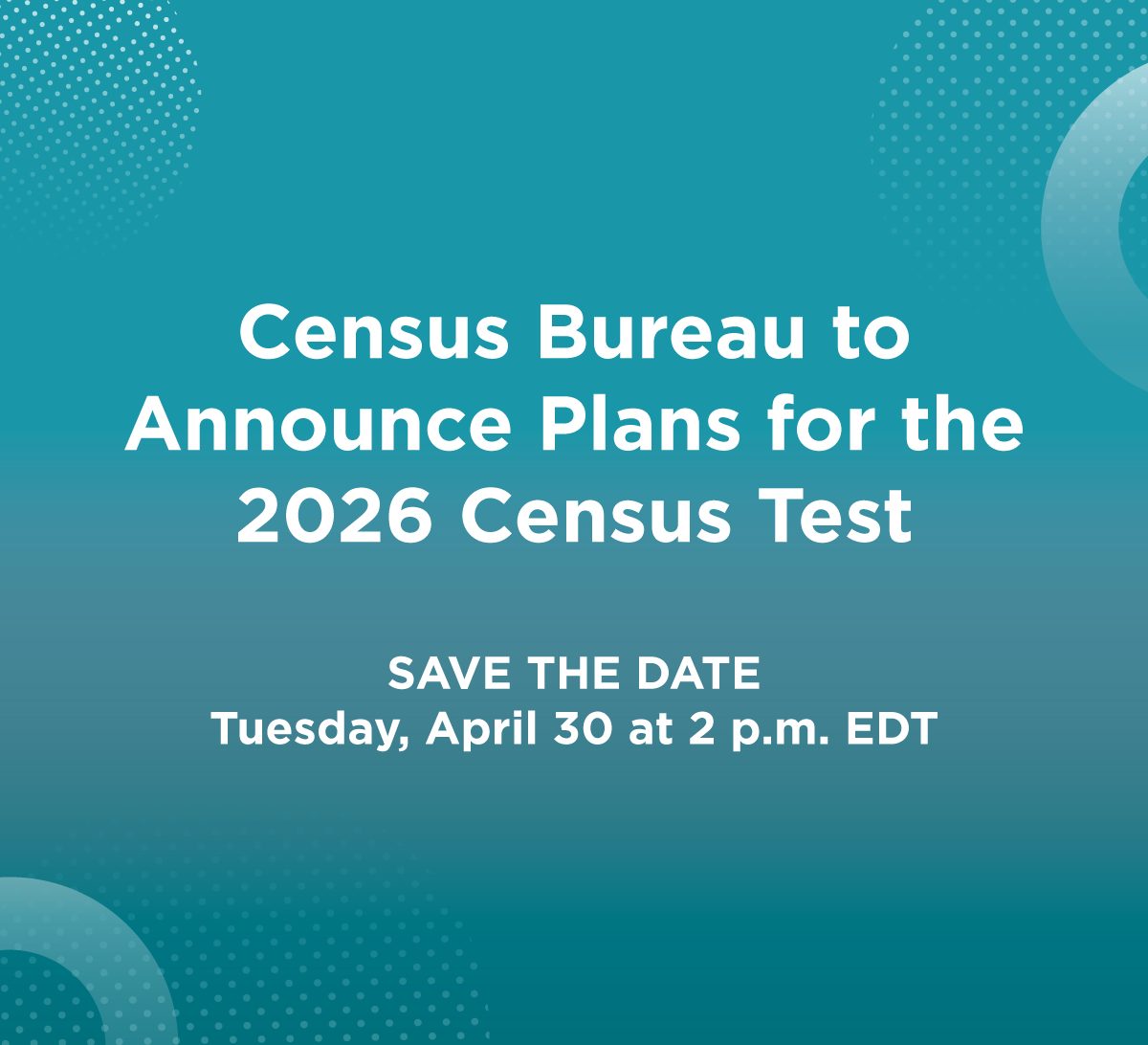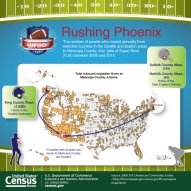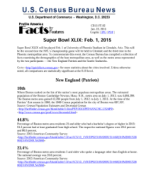Facts For Features: Super Bowl XLIX: Feb. 1, 2015
Super Bowl XLIX will be played Feb. 1 at University of Phoenix Stadium in Glendale, Ariz. This will be the second time the NFL’s championship game will be held in Glendale and the third time in the Phoenix metropolitan area. To commemorate this event, the Census Bureau has compiled a collection of facts examining the demographics of the host metropolitan area, as well as the metro areas represented by the two participants — the New England Patriots and the Seattle Seahawks.
Go to <//www.census.gov/quickfacts/> for more statistics about the cities involved. Unless otherwise noted, all comparisons are statistically significant at the 0.10 level.
Graphic [PDF] <1.0MB
New England (Patriots)
10th
Where Boston ranked on the list of the nation’s most populous metropolitan areas. The estimated population of the Boston-Cambridge-Newton, Mass.-N.H., metro area on July 1, 2013, was 4,684,299. The Boston metro area gained 42,204 people from July 1, 2012, to July 1, 2013. At the time of the Patriots’ first season in 1960, the 1960 Census population for the city of Boston was 697,197.
Source: Census Population Estimates and Decennial Census
<//factfinder.census.gov/bkmk/table/1.0/en/PEP/2013/PEPANNCHG.US24PR>
<//www.census.gov/prod/www/decennial.html>
44.8%
Percentage of Boston metro area residents 25 and older who had a bachelor’s degree or higher in 2013; 91.2 percent had at least graduated from high school. The respective national figures were 29.6 percent and 86.6 percent.
Source: 2013 American Community Survey
<//factfinder.census.gov/bkmk/table/1.0/en/ACS/13_1YR/DP02/310M200US14460|310M200US38060|310M200US42660>
23.4%
Percentage of Boston metro area residents 5 and older who spoke a language other than English at home. The national average was 20.8 percent.
Source: 2013 American Community Survey
<//factfinder.census.gov/bkmk/table/1.0/en/ACS/13_1YR/DP02/310M200US14460|310M200US38060|310M200US42660>
$72,907
Median household income for the Boston metro area. The national median was $52,250.
Source: 2013 American Community Survey
<//factfinder.census.gov/bkmk/table/1.0/en/ACS/13_1YR/DP03/310M200US14460|310M200US38060|310M200US42660>
$363,200
Median home value of owner-occupied homes in the Boston metro area. The national median was $173,900.
Source: 2013 American Community Survey
<//factfinder.census.gov/bkmk/table/1.0/en/ACS/13_1YR/DP04/310M200US14460|310M200US38060|310M200US42660>
30.0 minutes
Average amount of time it took Boston metro area residents to get to work; 68.7 percent of the metro area’s workers drove to work alone, 6.9 percent carpooled and 12.8 percent took public transportation. Nationally, it took an average of 25.8 minutes to get to work.
Source: 2013 American Community Survey
<//factfinder.census.gov/bkmk/table/1.0/en/ACS/13_1YR/DP03/310M200US14460|310M200US38060|310M200US42660>
Seattle (Seahawks)
15th
Where Seattle ranked on the list of the nation’s most populous metropolitan areas. The estimated population of the Seattle-Tacoma-Bellevue, Wash., metro area on July 1, 2013, was 3,610,105. The Seattle area gained 57,514 people from July 1, 2012, to July 1, 2013. At the time of the Seahawks’ first season in 1976, the 1970 Census population for the city of Seattle was 530,831.
Source: Census Population Estimates and Decennial Census
<//factfinder.census.gov/bkmk/table/1.0/en/PEP/2013/PEPANNCHG.US24PR>
<//www.census.gov/prod/www/decennial.html>
39.4%
Percentage of Seattle metro area residents 25 and older who had a bachelor’s degree or higher in 2013; 91.7 percent had at least graduated from high school. The respective national figures were 29.6 percent and 86.6 percent.
Source: 2013 American Community Survey
<//factfinder.census.gov/bkmk/table/1.0/en/ACS/13_1YR/DP02/310M200US14460|310M200US38060|310M200US42660>
22.3%
Percentage of Seattle metro area residents 5 and older who spoke a language other than English at home. The national average was 20.8 percent.
Source: 2013 American Community Survey
<//factfinder.census.gov/bkmk/table/1.0/en/ACS/13_1YR/DP02/310M200US14460|310M200US38060|310M200US42660>
$67,479
Median household income for the Seattle metro area. The national median was $52,250.
Source: 2013 American Community Survey
<//factfinder.census.gov/bkmk/table/1.0/en/ACS/13_1YR/DP03/310M200US14460|310M200US38060|310M200US42660>
$307,900
Median home value of owner-occupied homes in the Seattle metro area. The national median was $173,900.
Source: 2013 American Community Survey
<//factfinder.census.gov/bkmk/table/1.0/en/ACS/13_1YR/DP04/310M200US14460|310M200US38060|310M200US42660>
28.6 minutes
Average amount of time it took Seattle metro area residents to get to work; 69.7 percent of the metro area’s workers drove to work alone, 9.9 percent carpooled and 9.3 percent took public transportation. (Note: The percentage of workers that carpooled is not statistically different from the percentage that took public transportation.) Nationally, it took an average of 25.8 minutes to get to work.
Source: 2013 American Community Survey
<//factfinder.census.gov/bkmk/table/1.0/en/ACS/13_1YR/DP03/310M200US14460|310M200US38060|310M200US42660>
Host Site
12th
Where Phoenix ranked on the list of the nation’s most populous metropolitan areas. The estimated population of the Phoenix-Mesa-Scottsdale, Ariz., metro area on July 1, 2013, was 4,398,762. The Phoenix area gained 71,130 people from July 1, 2012, to July 1, 2013.
Source: Census Population Estimates
<//factfinder.census.gov/bkmk/table/1.0/en/PEP/2013/PEPANNCHG.US24PR>
234,632
Population of Glendale, Ariz., location of University of Phoenix Stadium where Super Bowl XLIX will be played.
Source: Census Population Estimates
<//factfinder.census.gov/bkmk/table/1.0/en/PEP/2013/PEPANNRSIP.US12A>
87th
Where Glendale ranked on the list of the nation’s most populous cities.
Source: Census Population Estimates
<//factfinder.census.gov/bkmk/table/1.0/en/PEP/2013/PEPANNRSIP.US12A>
29.2%
Percentage of Phoenix metro area residents 25 and older who had a bachelor’s degree or higher in 2013, which is not statistically different from the national figure of 29.6 percent; 86.5 percent had at least graduated from high school, which is not statistically different from the national figure of 86.6 percent.
Source: 2013 American Community Survey
<//factfinder.census.gov/bkmk/table/1.0/en/ACS/13_1YR/DP02/310M200US14460|310M200US38060|310M200US42660>
25.8%
Percentage of Phoenix metro area residents 5 and older who spoke a language other than English at home. The national figure was 20.8 percent.
Source: 2013 American Community Survey
<//factfinder.census.gov/bkmk/table/1.0/en/ACS/13_1YR/DP02/310M200US14460|310M200US38060|310M200US42660>
$51,847
Median household income for the Phoenix metro area, which is not statistically different from the national median of $52,250.
Source: 2013 American Community Survey
<//factfinder.census.gov/bkmk/table/1.0/en/ACS/13_1YR/DP03/310M200US14460|310M200US38060|310M200US42660>
$177,900
Median home value of owner-occupied homes in the Phoenix metro area. The national median was $173,900.
Source: 2013 American Community Survey
<//factfinder.census.gov/bkmk/table/1.0/en/ACS/13_1YR/DP04/310M200US14460|310M200US38060|310M200US42660>
25.8 minutes
Average amount of time it took Phoenix metro area residents to get to work; 76.5 percent of the metro area’s workers drove to work alone, 10.9 percent carpooled and 2.6 percent took public transportation. Nationally, it also took an average of 25.8 minutes to get to work.
Source: 2013 American Community Survey
<//factfinder.census.gov/bkmk/table/1.0/en/ACS/13_1YR/DP03/310M200US14460|310M200US38060|310M200US42660>
The following is a list of observances typically covered by the Census Bureau’s Facts for Features series:
| Black (African American) History Month (February) Super Bowl Valentine's Day (Feb. 14) Women's History Month (March) Irish-American Heritage Month (March)/ St. Patrick's Day (March 17) Earth Day (April 22) Asian/Pacific American Heritage Month (May) Older Americans Month (May) Mother's Day Hurricane Season Begins (June 1) Father's Day |
The Fourth of July (July 4) Anniversary of Americans With Disabilities Act (July 26) Back to School (August) Labor Day Grandparents Day Hispanic Heritage Month (Sept. 15-Oct. 15) Unmarried and Single Americans Week Halloween (Oct. 31) American Indian/Alaska Native Heritage Month (November) Veterans Day (Nov. 11) Thanksgiving Day The Holiday Season (December) |
Editor’s note: The preceding data were collected from a variety of sources and may be subject to sampling variability and other sources of error. Facts for Features are customarily released about two months before an observance in order to accommodate magazine production timelines. Questions or comments should be directed to the Census Bureau’s Public Information Office: telephone: 301-763-3030; or e-mail: pio@census.gov.








